With Wydad Casablanca and RS Berkane winning the CAF Champions League and CAF Confederations Cup respectively, the Moroccan Botola Pro has a compelling argument for being the strongest league in Africa. After overcoming Algerian league leaders CR Belouizdad and Angolan champions Petro de Luanda in the knockout stages, Wydad were rightfully crowned champions of Africa in their home stadium after beating Egypt’s Al Ahly 2-0. Preventing Pitso Mosimane’s Al Ahly from winning three consecutive CAF Champions League titles is a superb achievement from Walid Regragui’s side. Despite this continental triumph being arguably the most wanted trophy in Africa, Wydad’s trophy hunt continues domestically.
Currently leading the Botola Pro and fierce rivals Raja Casablanca by four points with six games remaining, Wydad are attempting to become back-to-back Moroccan champions. This is a feat that has not been accomplished for nearly 20 years, further proof of the strength of the league. However, to bring any form of domestic success, Wydad must deal with Raja in their matchups in the league and cup quarter-finals. In this tactical analysis in the form of a team scout report, we will discuss Walid Regragui’s tactics that have earned Wydad Casablanca the title of Africa’s best.
In possession
Over the last 10 years in the game, there has been an increase in the correlation between successful teams and high ball possession. However, in this season’s competitions, we’ve seen Roma win the UEFA Conference League final with 35% possession, and Wydad Casablanca win the CAF Champions League final with 38% possession. Additionally, Real Madrid, Eintracht Frankfurt, and RS Berkane won their continental finals with less than 50% possession. There is a trend in Wydad’s possession statistics this season, showing that they allow stronger opposition to have more ball possession. In their eleven Champions League group stage and knockout fixtures this season, Wydad had more possession than their opponents in just three games. Although, in the Botola Pro, Wydad rank 3rd for average possession and their impressive PPDA against of 15.22 shows their ball retention capability.
In possession, Regragui’s team usually play more direct, attempting 50.35 long passes per game with an accuracy of 56.5%, the third most long passes in the Botola this season. Goalkeeper Ahmed Reda Tagnaouti usually kicks long from goal kicks. The target for direct build-up is striker Guy Mbenza (184cm/6’0”), with support from the central midfield trio and the two wingers. The central midfielders provide deeper support with the potential for controlling second balls, meanwhile, the winger’s movement tends to go beyond Mbenza for flick-ons.
Tagnaouti’s overall passing accuracy of 86.33% displays a relatively reliable goalkeeper when in possession, comfortable playing short but able to launch longer passes. The issue that arises is Mbenza’s ability in the air, despite being a physical presence. Mbenza’s aerial duel success rate of 28% ranks him 244th out of 287 outfield players to have played 500 minutes in the Botola. Wydad have more squad members with a worse percentage, including direct build-up support players like Reda Jaadi and wingers Zouhair El Moutaraji and Salaheddine Benyachou.
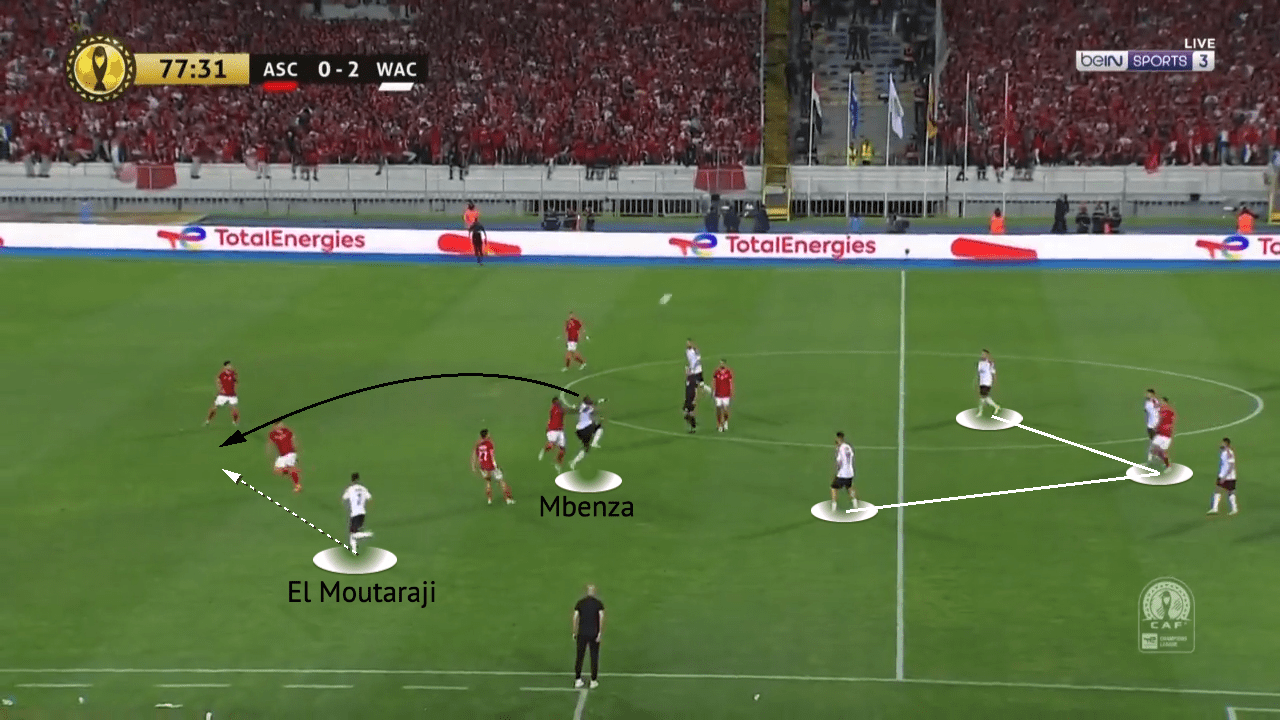
This figure shows an example of Tagnaouti’s direct build-up towards Mbenza. As Mbenza jumps for the aerial duel, El Moutaraji makes a movement behind for the potential flick-on. Jaadi coming off the right wing provides an unsuitable lateral option, but the midfield trio of Aymane El Hassouni, Jalal Daoudi and Yahya Jabrane are well-positioned for second balls.
Holding midfielder Jabrane and centre back Achraf Dari are at the heart of Wydad’s play in possession. Dari has completed the highest volume of long passes in the Botola this season, and ranks 3rd for total passes, which captain Jabrane tops. Jabrane has completed more progressive passes and more passes into the final third than any player in the Botola this season, showing his quality to progress the ball alongside offering ball retention. But Dari also provides progression, ranking 4th for progressive passes and 1st for ball progression per minute, above Jabrane in 2nd.
Regragui gives Jabrane the freedom as the pivot player to occupy spaces where he can receive possession and play forwards. Nevertheless, Jabrane is capable of receiving under pressure, with excellent use of his body to protect possession and the cleverness to execute disguised passes to beat opposition pressure. It’s common for Jabrane to drop between the centre backs to receive, but the most frequent area is towards the full-backs, especially the right-back space. The figure below is an example of this, with Jabrane and Daoudi forming a double pivot. Here, Dari passes to Jabrane in the right0back space, who receives and passes up the right-wing where Wydad have an overload due to the right-back pushing up. Wydad are constantly adjusting into a double pivot throughout matches to facilitate full-backs advancing, and the potential switch to a 4-2-2-2 when bringing on substitute striker Juhvel Tsoumou to partner Mbenza.
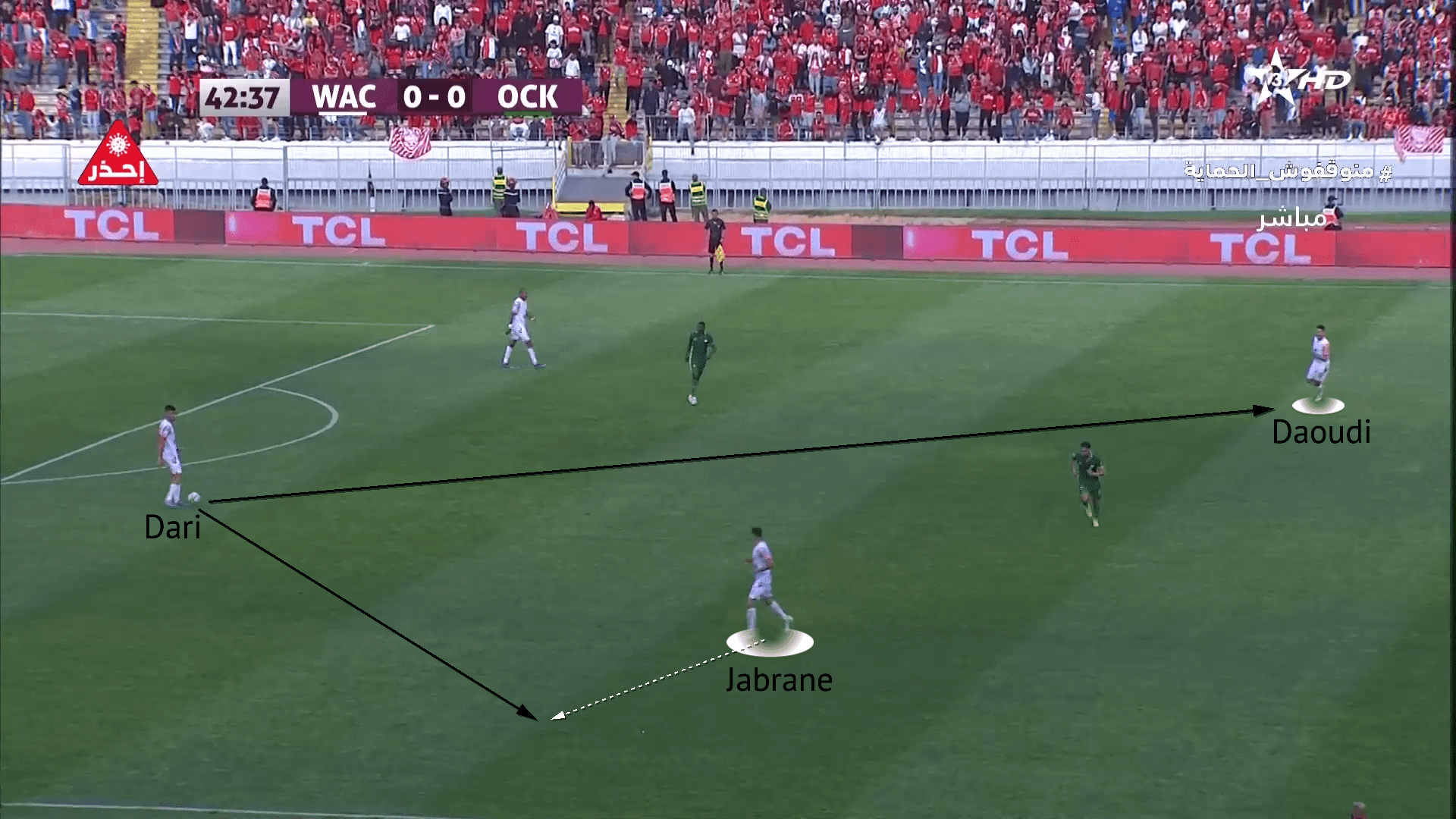
The figure below is an example of Jalal Daoudi occupying the right-back space, allowing right back Ayoub El Amloud to advance against Maghreb de Fès. This rotation to right-back is crucial for Wydad to build up and progress due to El Amloud’s deficiencies.
When on the ball, the right-back looks nervy, tending to take few touches and often being too direct and forceful in possession. He seems to lack confidence receiving with his back to goal, which is a regular occurrence for full-backs in the build-up. Meanwhile, left-back Yahia Attiyat Allah is technically proficient, performs well with the natural angles at left-back and is unfazed by pressure towards the touchline constraint due to his superb ball-manipulation and technique. In comparison to El Amloud, Allah completes more passes into the final third and the penalty box, and more progressive passes and through passes, with significantly better accuracy.
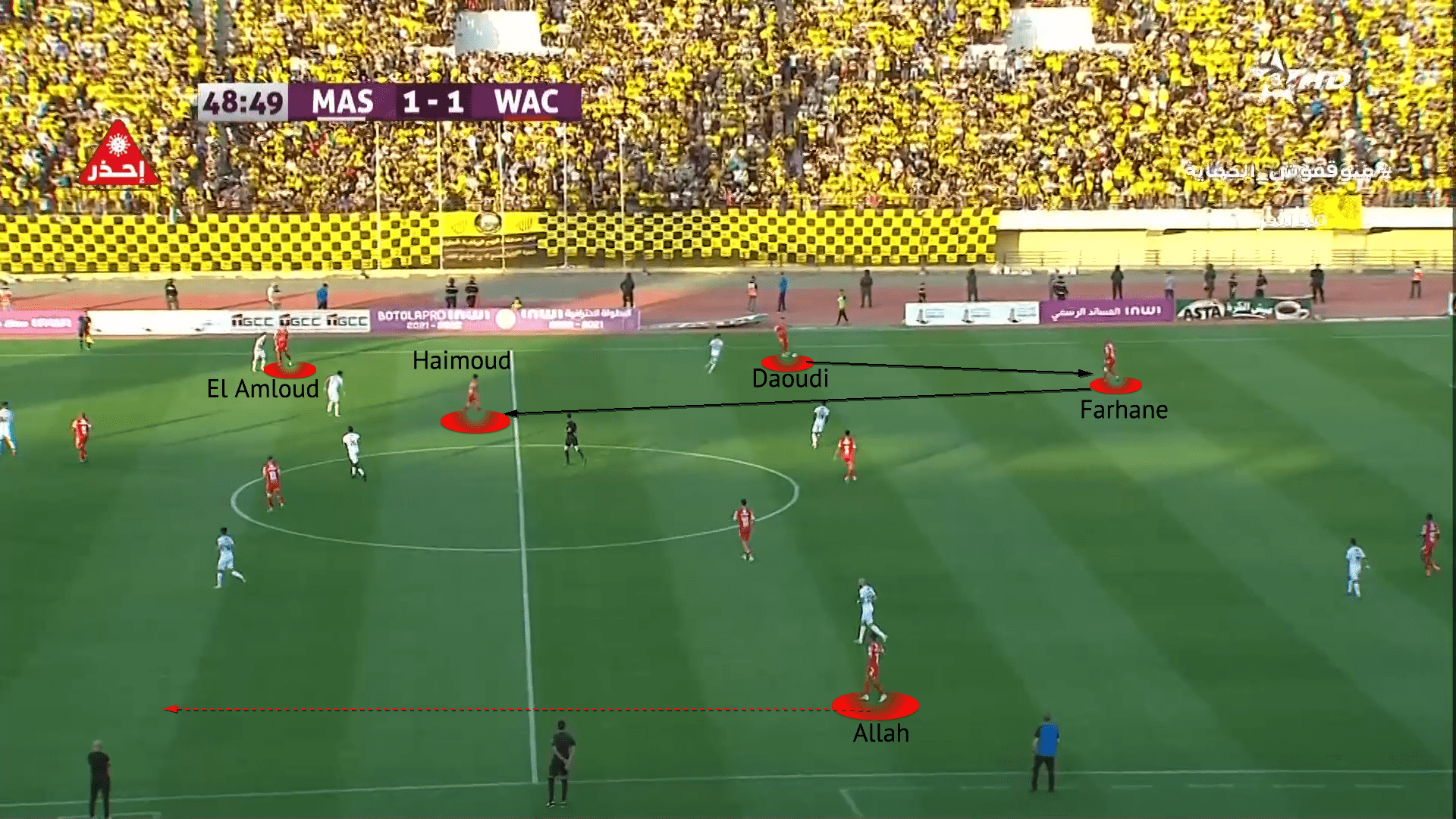
Both the figures above and below show how Wydad can switch to a 2-3-4-1 formation when in possession. With El Amloud and Allah advancing from full-back to be the width holders in attack, Wydad’s wingers are allowed to invert. This creates a line of four that is stretched across the final third, providing options for penetrative passes from deeper players whilst supporting Mbenza as the lone striker. In this analysis, we’ve mentioned Dari and Jabrane’s valuable progressive actions, but midfielder Daoudi also ranks 12th out of 71 central midfielders to have played 600 minutes in the Botola for passes into the final third with 8.45 p90. These five attacking players, sometimes joined by a central midfielder to make six, are the key targets for Dari, Jabrane, and Daoudi’s passes.
With the full-backs advancing high and wide and Wydad possessing a focal point striker like Guy Mbenza, many would expect Regragui’s side to attempt lots of crosses. However, Wydad rank 11th for crosses out of the 16 teams in the Botola Pro. Additionally, Allah and El Amloud rank 11th and 22nd for crosses out of 58 full-backs to have played 600 minutes in the Botola. Perhaps surprisingly, the league leaders only rank 5th for touches in the opposition penalty box, relying on the attackers and Mbenza, in particular, to be efficient with the chances they have, with Mbenza still managing the 4th most touches in the box in the league this season.
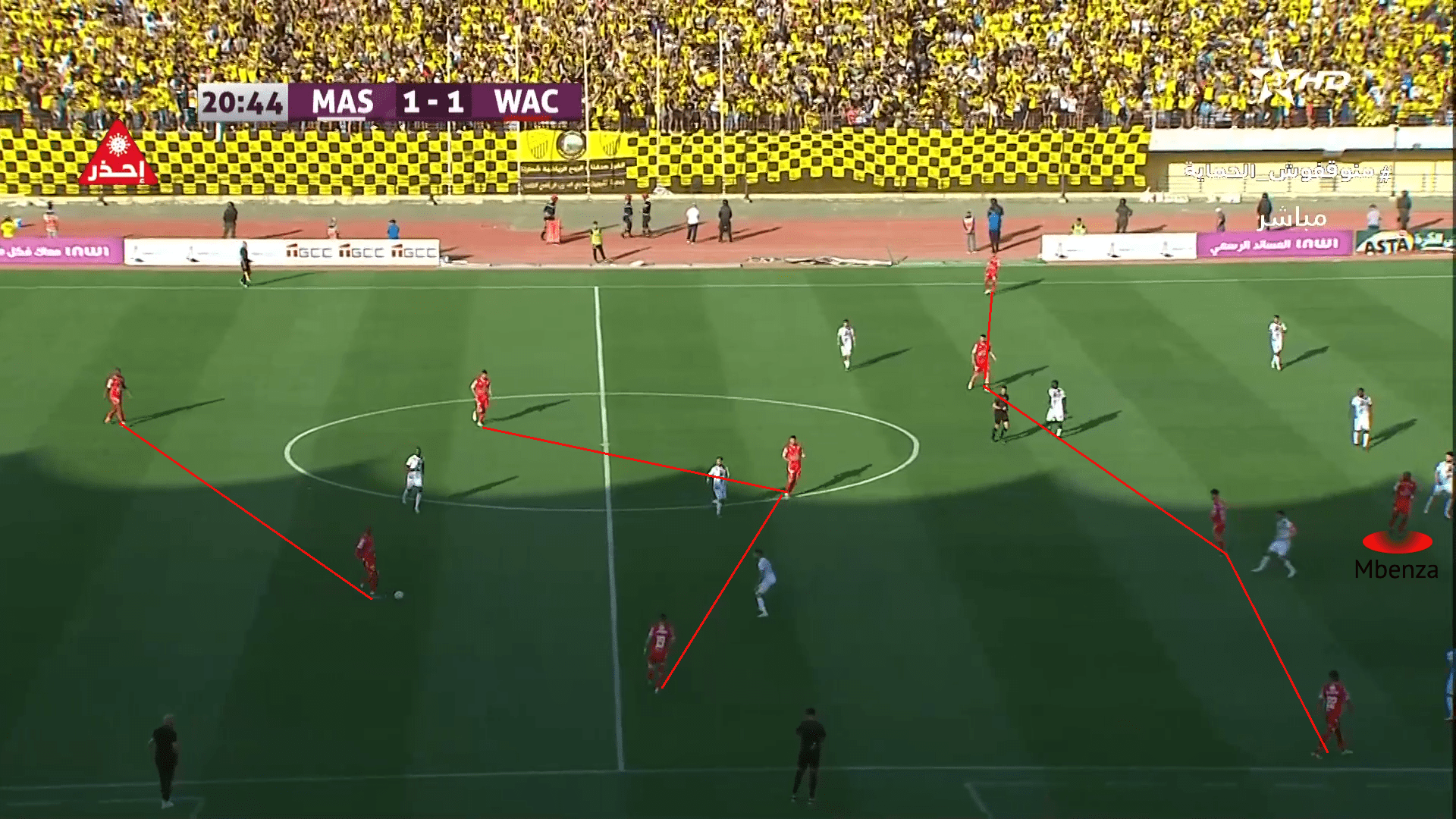
Guy Mbenza is a suitable physical and stylistic profile for what is required at Wydad. The current top scorer in the Botola Pro with 12 goals from 8.31 xG, Mbenza manages to get 50% of his shots on target. Challenging the goalkeeper often, he is able to generate great power even when unbalanced and can shift the ball out of his feet for a shot opportunity quickly. Not just a goalscoring threat, Mbenza ranks 3rd for xA p90 out of 41 strikers to have played 600 minutes in the Botola, and 4th for key passes p90 with 0.68. The Congolese striker on loan from Royal Antwerp also runs the channels and is the target of long balls and throw-ins, aiming to produce attacking opportunities from scraps. Mbenza is above the league average for dribbling and offensive duel success rate, with 45% crossing accuracy to help create from wider areas.
Attacking set-pieces
From attacking corners, Wydad Casablanca attempt inswinging deliveries towards the front zone/near post. Primarily, right-footed Jalal Daoudi and left-footed Yahia Attiyat Allah are the corner takers, although right-footed Reda Jaadi is another option. These are also the common free-kick takers. Usually, Wydad have four players around the six-yard box, with a further two players behind the penalty spot. Most players will dart towards the front zone, with the remaining players drifting towards the back post, providing different options for delivery and potential flick-ons. Walid Regragui consistently wants his team to have one man on the edge of the box.
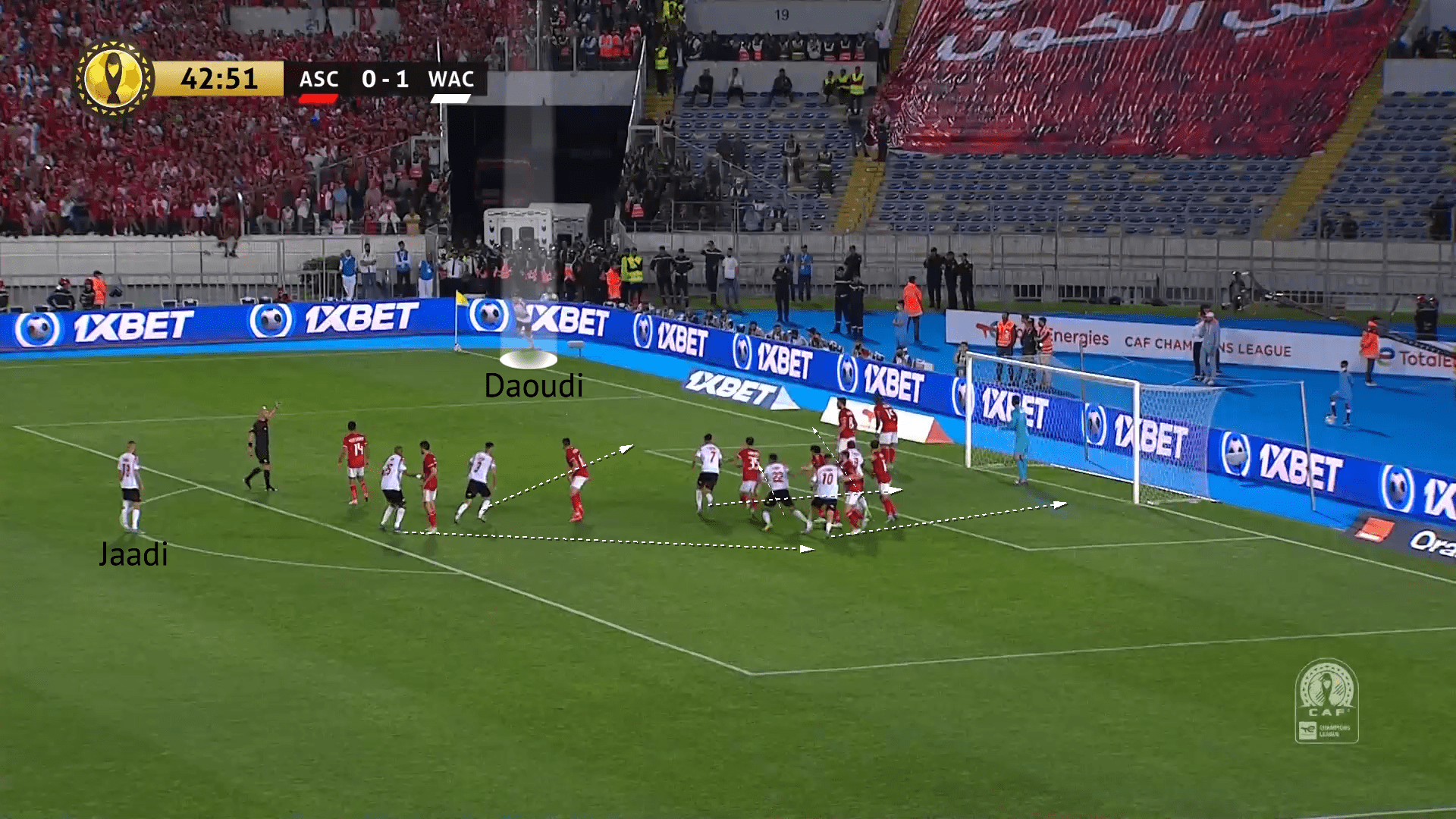
In the figure above, there are four Wydad players near the six-yard box with two players behind the penalty spot. Three players from the six-yard box move towards the front zone, with one of the deeper players making a run into the front zone as well. #10 El Hassouni makes a run to the back post and the remaining player in the box also drifts towards the back post, with the possibility of diverting near-post flick-ons into the goal. Wydad’s centre back pairing always enter the opposition box for corners, and is usually split with one attacking the front zone and the other moving into areas for rebounds and flick-ons.
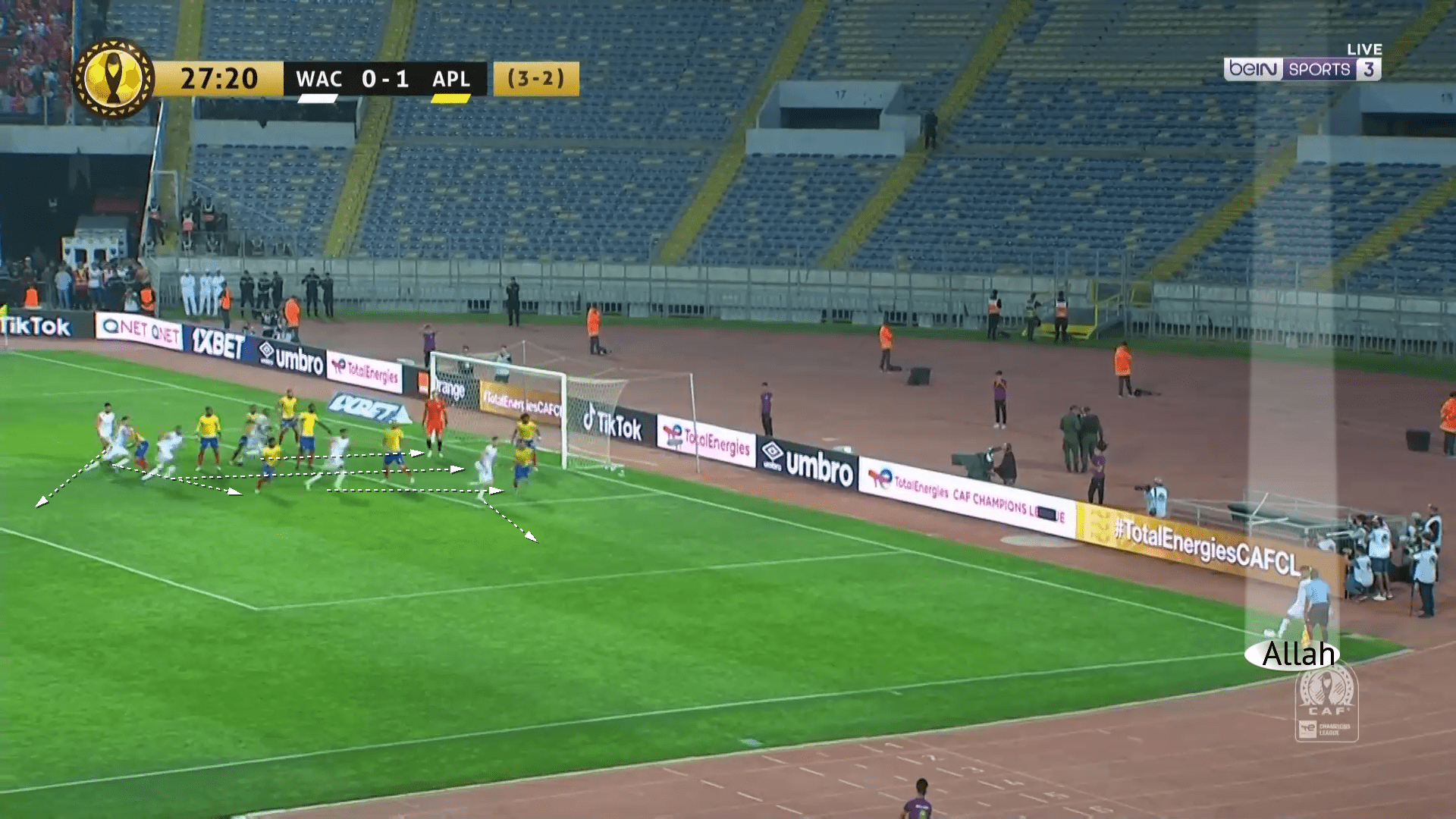
In this example from left-footed Allah against Petro de Luanda, there are three Wydad players near the six-yard box and three deeper. Again, a total of four players make a run towards the front zone, but no back post option is provided, as one of the remaining players drops back and another supports just behind the front zone. From this inch-perfect Allah delivery over the first man, centre back Amine Farhane can enter the front zone from deep and score a free header, after not being picked up by the Angolan side’s zonal marking.
Out of possession
As stated earlier in the analysis, Wydad Casablanca allow better opponents to have more ball possession than weaker opponents (most Botola Pro teams). In the Botola Pro this season, Wydad have conceded the fewest shots, at an average of 5.45 per game. Their total of 143 is 46 fewer than the total of second-ranked Maghreb de Fès, who are notably tough to beat and have conceded the fewest goals so far this season. Wydad prevent a large number of shots against them by having a solid midfield set-up. With a PPDA of 8.02, ranked 4th in the league, Regragui’s team usually allow opposition possession in the first phase of build-up, not applying much pressure and choosing to direct their efforts to block progressive passing options. Wydad typically do this in their 4-1-4-1 formation.
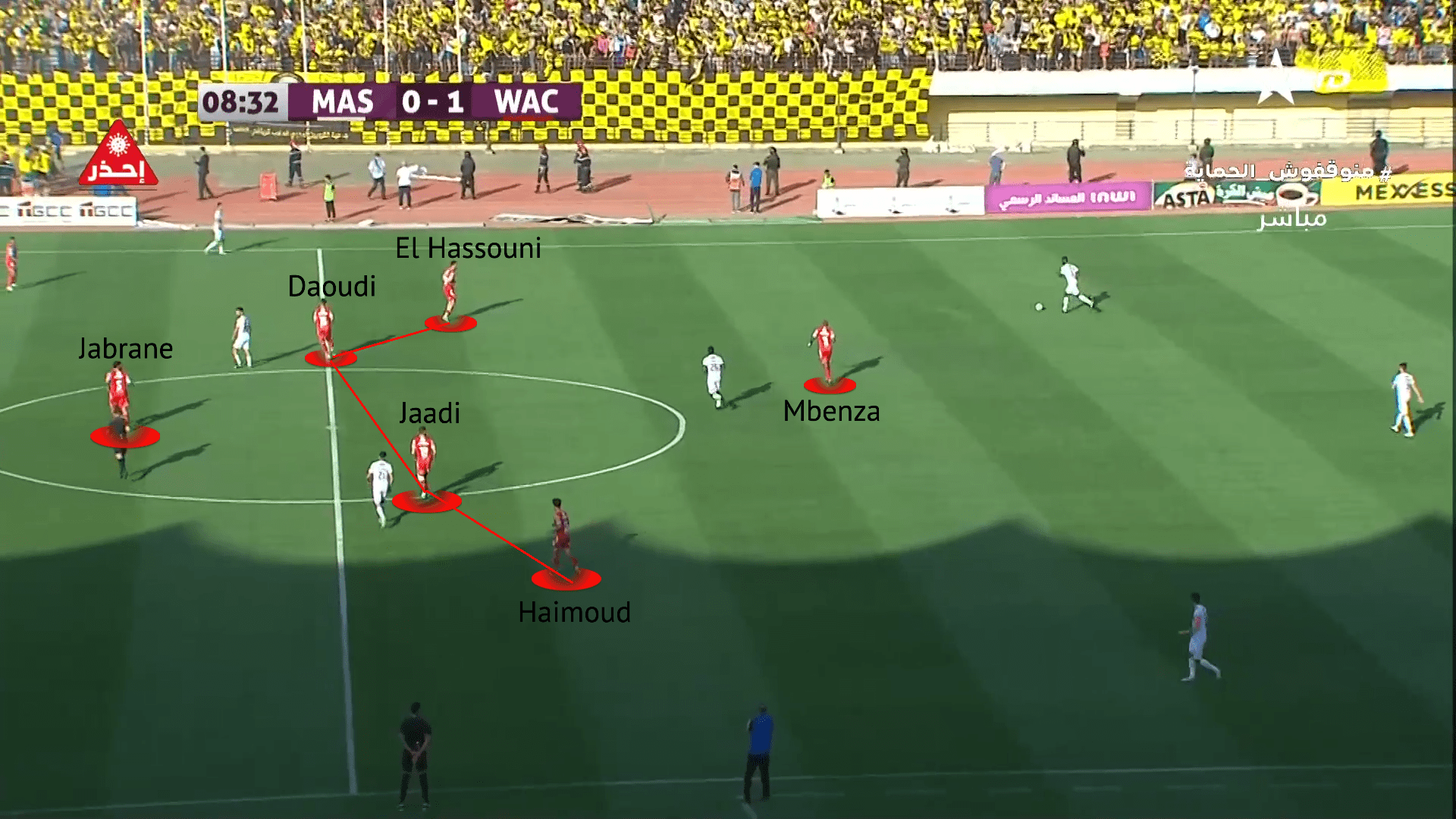
The figure above displays Wydad’s 4-1-4-1 shape against Maghreb de Fès. Striker Mbenza is responsible for cutting off the passing lane into the Maghreb pivot player. The narrow midfield unit of four prevents central progression, looking to force the ball wide to then press in-to-out against the touchline. Jabrane is positioned between the lines behind the midfield four.
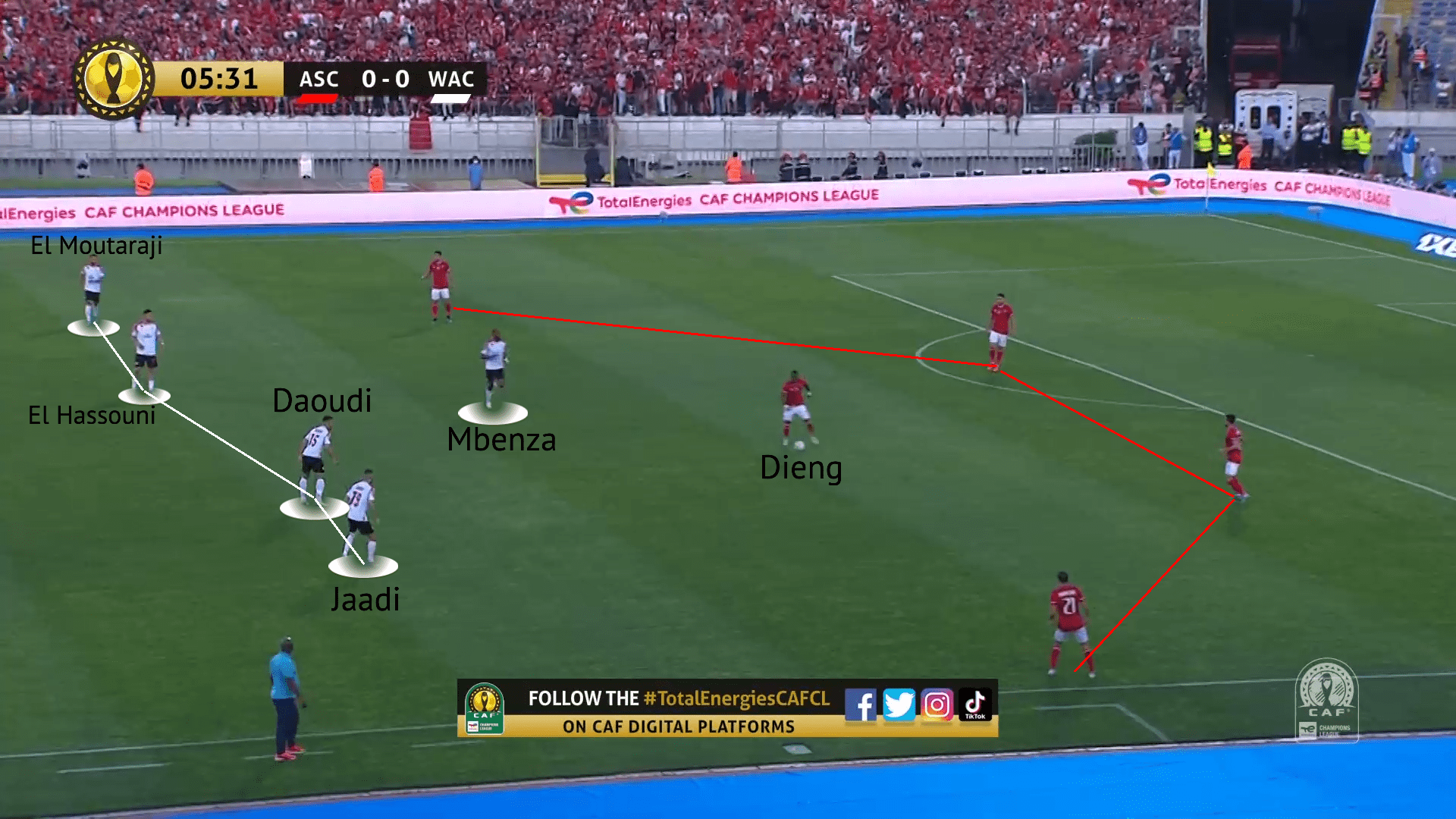
This figure from the CAF Champions League final against Al Ahly shows how Wydad’s defensive structure has frustrated the Egyptians. Aliou Dieng, a Mali international and one of the best players in Africa, has dropped deep to get in front of Mbenza, who had prevented the midfielder from receiving possession. With the Al Ahly left back, centre back pairing, and another central midfielder alongside Dieng all deeper than Mbenza, they lack a link between the defence and attack.
This scenario forced by Wydad’s defensive structure increases the opposition’s likelihood of attempting lofted passes to progress possession. This is a favourable situation for Wydad. Centre backs Dari and Cheick Comara are ranked 1st and 3rd in the league for aerial duels, with both successful in nearly 75% of their duels. In midfield, Daoudi and Jabrane are the top 2 central midfielders in the Botola for aerial duel success, with 70.59% and 68.13% respectively.
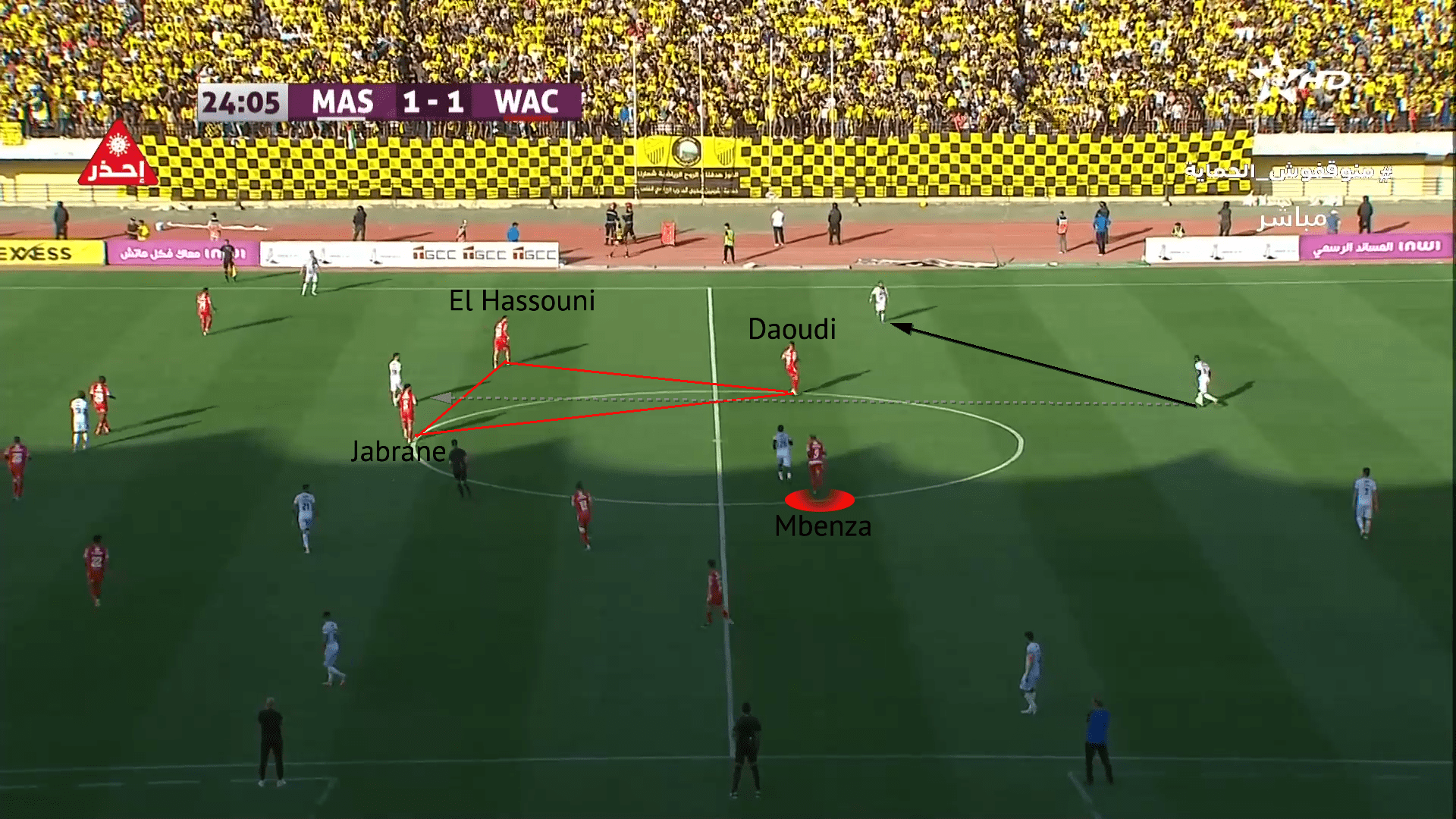
It is common for Wydad to convert their 4-1-4-1 shape into a 4-4-2 to help dictate opposition play and set pressing traps. In the example above, Mbenza continues to occupy the same spaces as the opposition and Daoudi has stepped out of midfield to create the front two. By doing this, the opposition central midfielder is in Daoudi’s cover shadow, unable to receive. This delays Maghreb’s progression and allows the Wydad midfield to shift across, with Jabrane and El Hassouni positioned to also prevent central progression and force the ball wide.
As the pass is made wide to the full-back, Wydad continue with their triangle to prevent the pass to the central midfielder. This means the right-back must play backwards to retain possession or pass to the winger who is followed by left-back Allah with his back to goal. The right-back decides to pass to the right-winger. This triggers Wydad to press the winger, using the touchline as a constraint and overloading Maghreb 4vs3 on the wing. Receiving pressure from Allah, the winger attempts a pass inside, which is inevitably intercepted with Wydad able to regain possession.
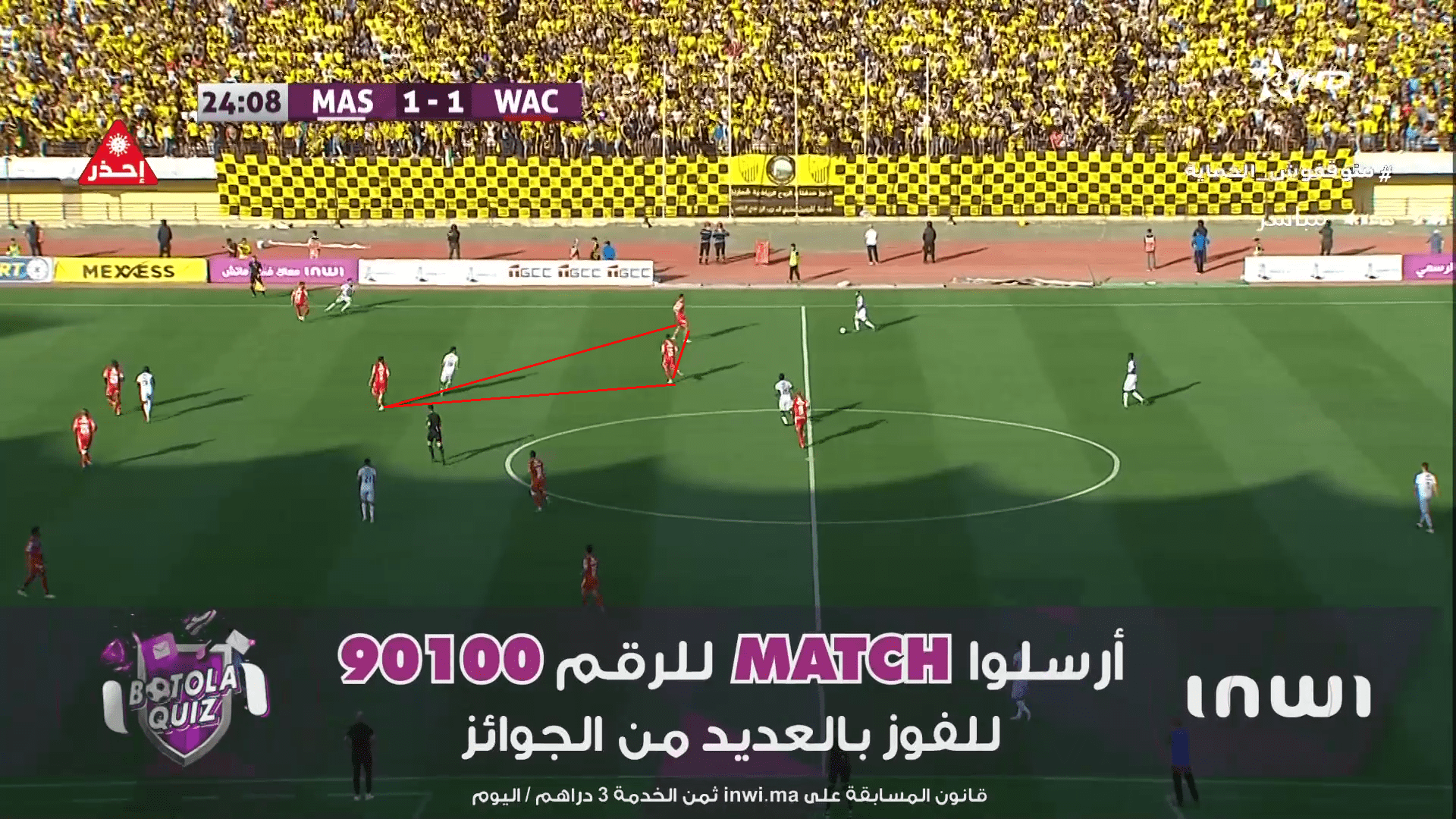
The figure below is another example of Wydad setting a trigger with two forwards. Once more, Jalal Daoudi joins Mbenza in the front line from midfield, with right-winger Jaadi narrowing to help cover the space left by Daoudi. With Daoudi and Mbenza positioned to prevent progressive passes, Al Ahly’s left centre back plays a lateral pass to the right centre back. This triggers Mbenza to press, as the right centre back has been the targeted weak point all game. Mbenza presses with an increased intensity than usual, causing a poor first touch from the centre back and then a rushed, inaccurate pass into midfield. The pass is intercepted in midfield by El Hassouni and leads to El Moutaraji unleashing a powerful strike into the top corner that put Wydad ahead in the CAF Champions League final.
Unlike the example from the Maghreb de Fès fixture, this example does not include Jabrane in the midfield line. The holding midfielder is trusted to recognise situations and determine whether he is better positioned to prevent opposition progression by sitting deeper, more between the lines, or alongside the midfield unit in a bank of four. This role suits Jabrane, who has the tenacity to press out as the pivot player whilst also being accomplished at collecting second balls and regaining possession, ranking 15th in the Botola Pro for PAdj interceptions. If the opposition is able to beat Wydad’s defensive structure, Regragui’s side are not afraid of committing fouls, ranking 2nd in the Botola Pro for fouls committed so far this season. Only the 50 fouls committed by Yassine Labhiri of Mouloudia Oujda is greater than the total of 49 that Jabrane, Daoudi and El Hassouni have all committed this season.
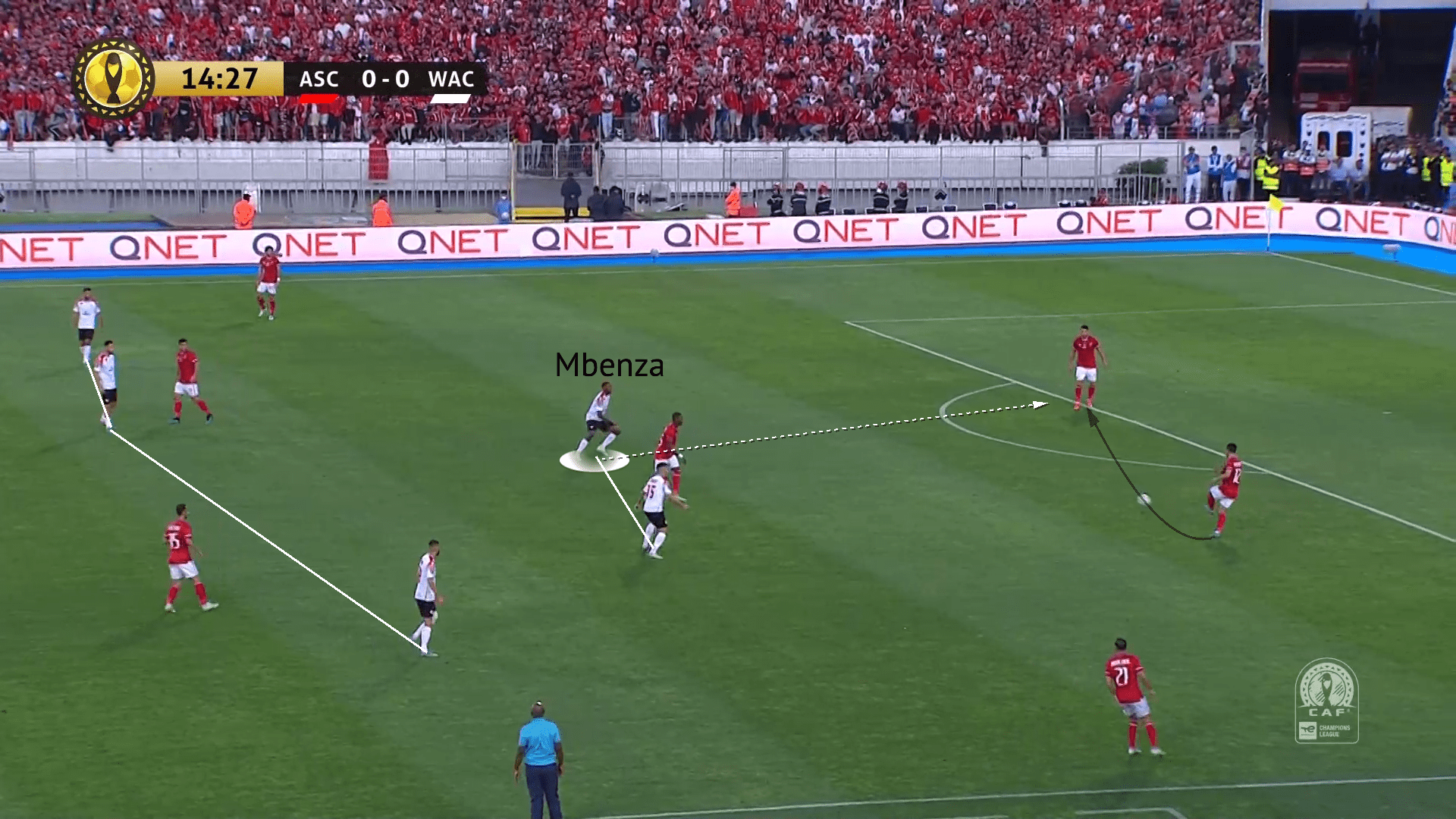
Defending set-pieces
When defending corners, the front zone is a priority for Wydad Casablanca, like how they prioritise this area for attacking corners. Defensively, they consistently have 2 players in the front zone. Elsewhere in the box, Wydad man-mark opposition, usually 4vs4 but sometimes opposition will commit five players into the box. When the opposition have one player disbanded away from his teammates, e.g. stood at the back post whilst teammates are on the penalty spot, Wydad will man-mark that player too. If this player is occupying the middle zone or positioned near the goalkeeper, the man-marking Wydad player will be sandwiched between the opponent and goalkeeper. Their actions to prevent the opponent from interfering with Tagnaouti are crucial, as Tagnaouti likes to come out and claim crosses.
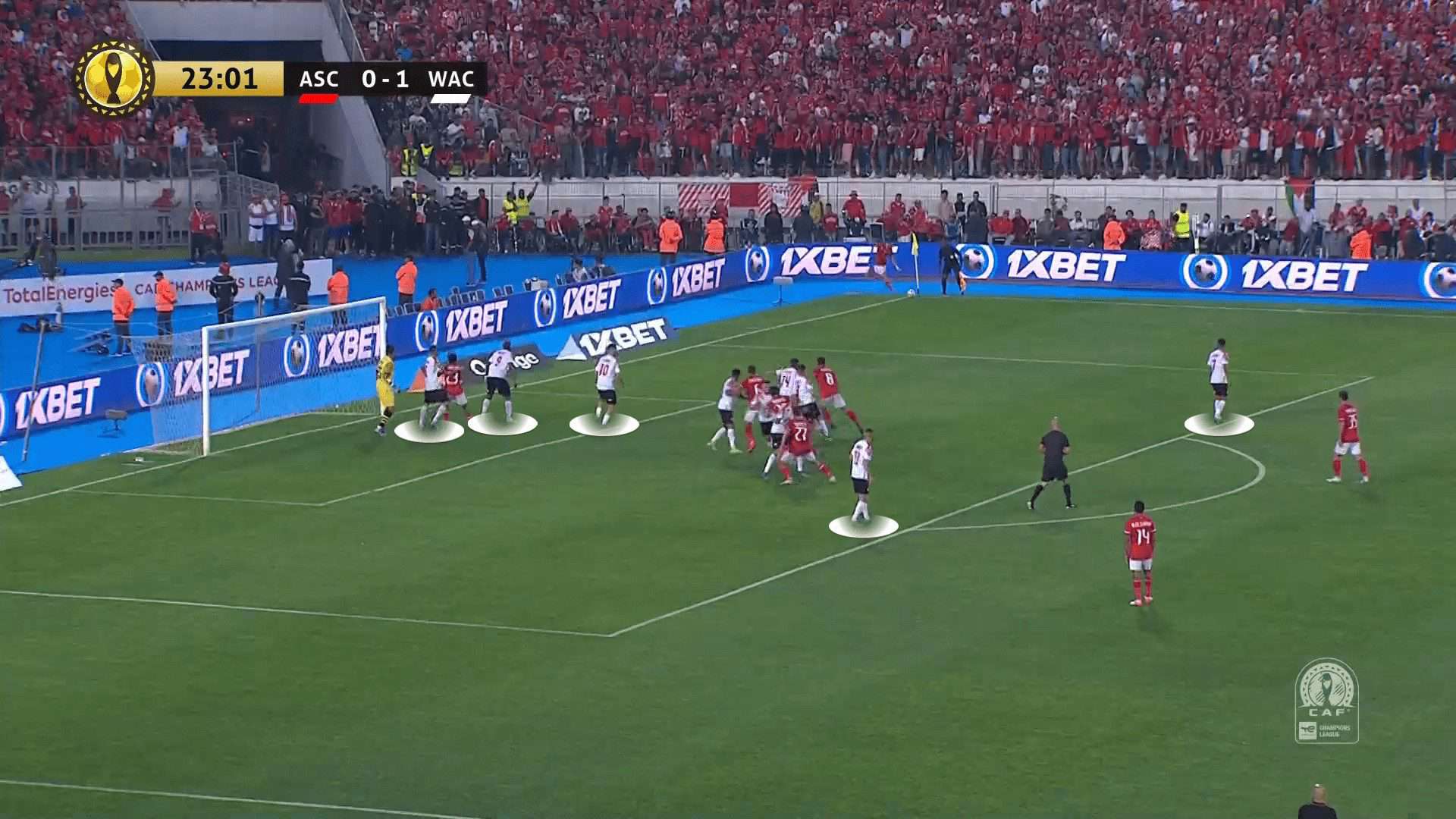
The figure above from the CAF Champions League final against Al Ahly shows lots of commonalities of Wydad’s defensive corner set-up. There are two players occupying the front zone and two players are positioned on the edge of the penalty box, both regular defensive set-piece occurrences. In this example, Wydad are man-marking near the penalty spot with another player positioned in that area to create a 5vs4. There is a player sandwiched behind an Al Ahly player providing a buffer between Tagnaouti.
It is not rare for Wydad to have all ten outfield players back, depending on the game state. In the Al Ahly example above, Wydad had entered the lead less than ten minutes earlier and this was Al Ahly’s first corner of the game. In the example below, all ten outfield players are in the Wydad box as they look to protect their narrow lead against Khouribga. Once more, Regragui’s team have flooded the front zone, but have left the back-post unoccupied, with two Khouribga players not being marked tightly.
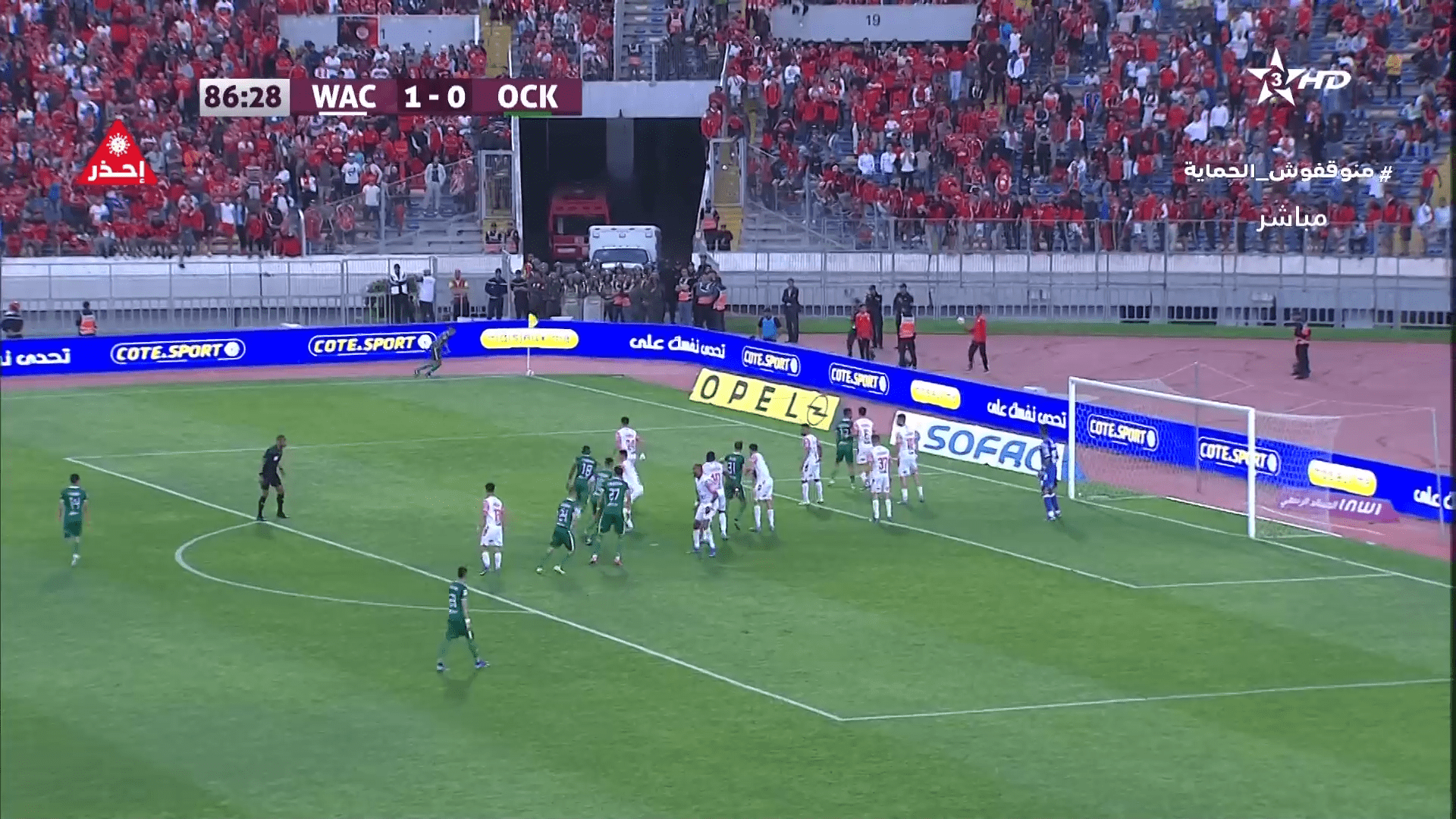
The figure below shows Wydad’s approach to opposition short corners. With two players near the corner taker, Wydad are able to influence the short corner decision making and the delivery of a corner into the box. They continue to position two players in the front zone, whilst man-marking opposition inside the box 5vs5. However, Wydad do not have a player on the edge of the box, choosing to have a man in the middle zone instead.
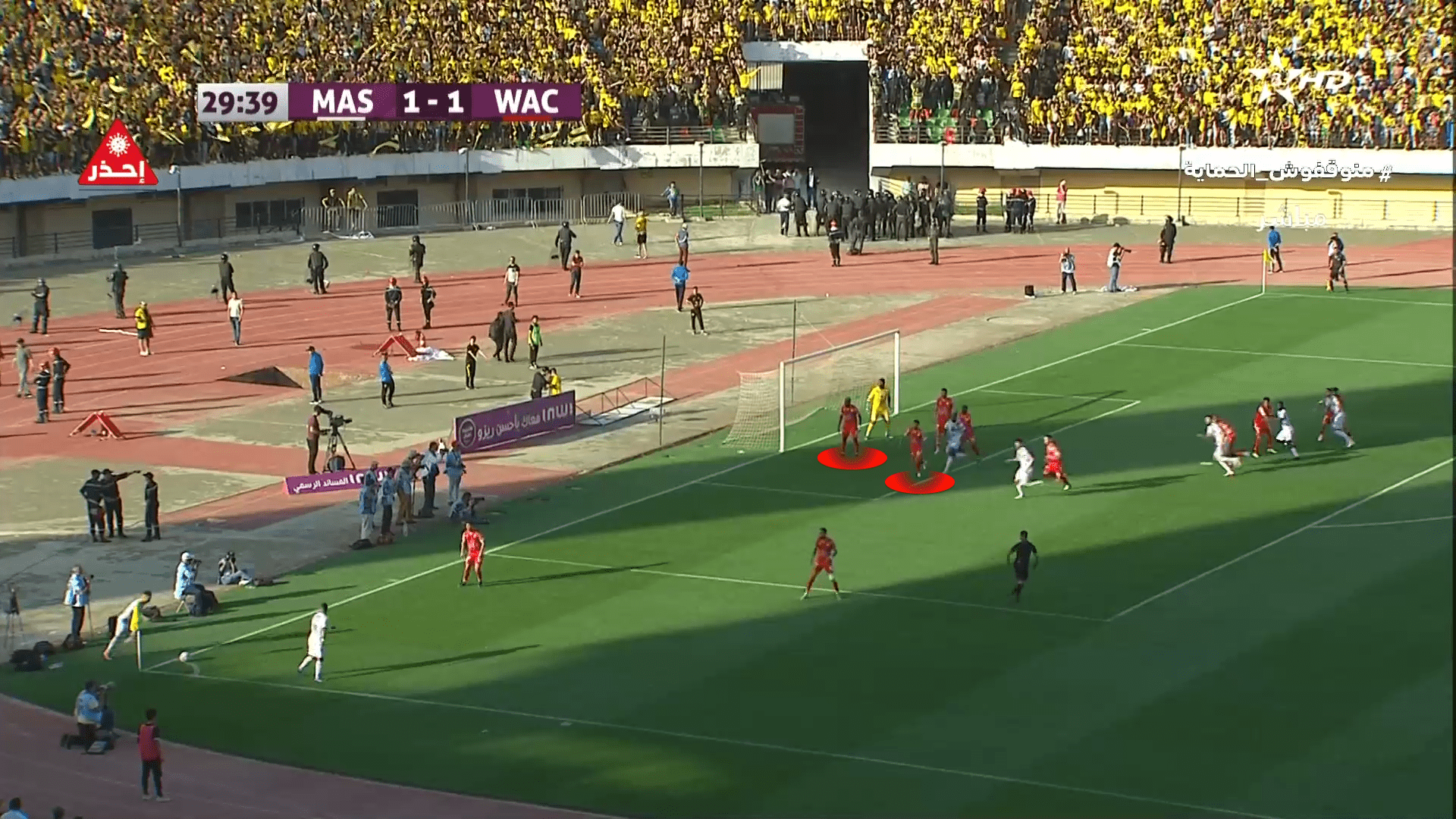
Conclusion
Winning the CAF Champions League is a remarkable achievement for Wydad Casablanca, especially when considering their domestic dreams too. With the Botola Pro league and the Moroccan Throne Cup up for grabs against rivals Raja, alongside the CAF Super Cup against fellow Moroccan side RS Berkane in August, Wydad’s season is far from over. This team analysis and scout report has discussed Walid Regragui’s tactics that have sustained Wydad’s charge on all fronts.
With Wydad and Berkane succeeding on the continent and the national team qualifying for back-to-back FIFA World Cups, it’s safe to say that Moroccan football is on the rise. Currently ranked 24th in the world, the second-highest-ranked African side behind Senegal in 20th, Morocco have a tough group with Belgium, Canada, and Croatia. Left-back Yahia Attiyat Allah is the only Wydad call-up this time (Tagnaouti and Jabrane have previously received call-ups in 2022), joining a squad with PSG’s Achraf Hakimi and newly transferred Bayern Munich man Noussair Mazraoui. Facing Percy Tau’s South Africa and Liberia in AFCON qualifiers, there was an opportunity for Achraf Dari to partner Nayef Aguerd and shut down former Brighton forward Tau once more on Thursday.






Comments